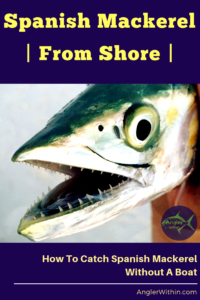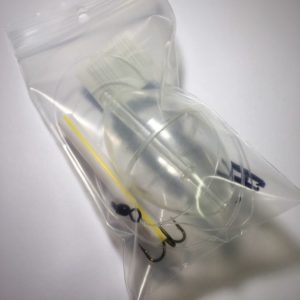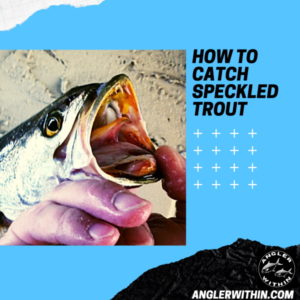Spanish mackerel are most commonly pursued by anglers from open water, but that’s certainly not the only way to catch them. Being primarily a land based fisherman, I used to wonder how to catch Spanish mackerel from shore.
What I found is that you actually have several options when it comes to targeting Spanish without a boat. Beaches, piers, jetties, bridges, and sometimes the banks of large bays are all excellent areas to find Spanish Mackerel.
When confined to land, you need a rod and reel that you can cast a long ways, so that you can hit schools that would normally be out of reach. You should use heavy lures, and fish them fast, as you won’t be able to outpace a hungry mackerel. A few of the best lure options are spoons, gotcha plugs, and bubble rigs (aka “straw rigs”).
Find out below how you can catch your fair share of these prized pelagics.
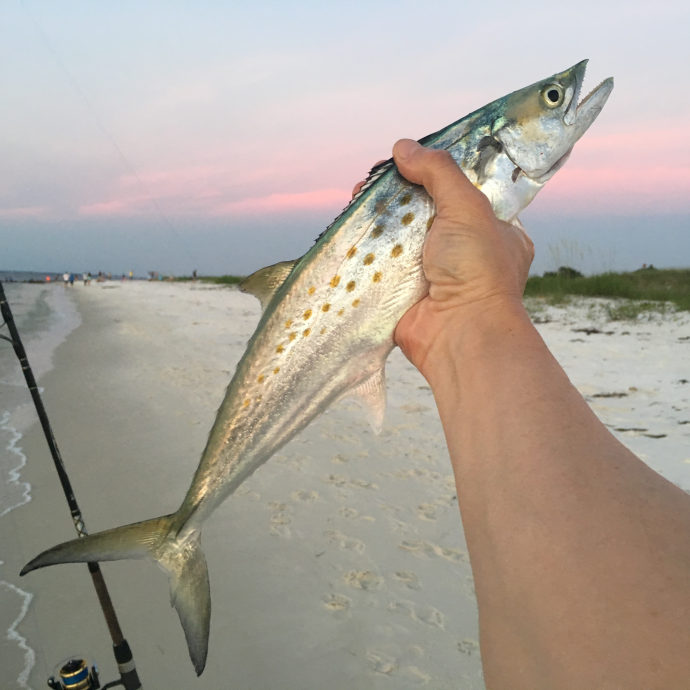
About Spanish Mackerel
Spanish mackerel are plentiful, and can be found along the coastline of all southern U.S. states. They are a migrating fish, and although they will venture beyond these areas, their primary range is from Virginia, around Florida, and all the way to Texas. They live in nearshore waters, and move up and down the coasts with changing water temps. They generally winter in south Florida and the Keys, moving northward as the water warms.
Spanish mackerel are schooling, open water hunters, that occasionally feed on shrimp and squid. But, their main game is finding, and slashing into balls of small bait fish that they herd to the surface. This herding behavior attracts feeding birds from above, which in turn clues us in to approaching schools. Spanish mackerel love anchovies, menhaden, scaled sardines (pilchards), threadfin herring, alewives and many other species of similar small fish.
They mature at 2 years of age, and can live up to 12 years. Most Spanish mackerel you catch will be under 3 pounds, but they can grow up to 13 pounds, a record currently held by North Carolina. A *6 pound Spanish would be a very nice fish.
*The state of North Carolina issues a “citation” for any Spanish mackerel over 6 pounds. You will receive a certificate signed by the governor. Other states have similar tournament programs for saltwater fishing.
Record Spanish Mackerel By State
- North Carolina - 13 lb (world record)
- Florida - 12 lb
- South Carolina - 11 lb
- Louisiana - 10.56 lb
- Virginia - 9 lb 13 oz
- Alabama - 8 lb 12 oz
- Texas - 8.74 lb
- Georgia - 8 lb 4 oz
- Mississippi - 8 lb
Spanish mackerel are first cousins to the king mackerel, and although they don’t grow as large as a king, they are just as ferocious. This aggressive personality makes for a popular game fish among the saltwater fishing community.
Spanish are so plentiful that their regulations are very generous. A common limit for most states is 15 per person with a length requirement of 12 inches to the fork. You will have to check your local regulations to be certain.
Spanish are typically very easy to catch when they are around, they fight hard, they taste great and they are easy to clean. So, Spanish mackerel are an ideal game fish for recreational anglers.
When And Where To Find Spanish Mackerel
When The Spaniards Invade
Because Spanish mackerel are a migrating fish, they will arrive in different locations at different times of the year, depending on weather. They should start showing up when the beach water temps hit 70 degrees in the spring, and will stick around until the water temps fall below that mark.
One great way to determine approximately when Spanish will show up in your area is to reference the NOAA website below. This url contains a water temperature table for U.S. coastal waters – NOAA water temps. You can use this table to reference the nearest data collection location to your fishing area. Then, you can determine when the magic water temps usually occur in your area.
As an example, Spanish mackerel fishing is good on the Alabama coast from April till early November. The NOAA tables back that up. They show that water temps usually hit 70 degrees sometime in April at Dauphin Island, and then they taper back off into the 60’s come November.
The specific dates of when water temps will “get right” in a given year will be dictated by weather patterns. So, a better option is to seek out real time local fishing reports in your area. That’s the best way to know when the Spanish are actually around.
Your local fishing reports might be found on Facebook, tackle shop websites, fishing guide websites, forums, or some other random website. You will have to search the web, or ask around for the best options in your area. Usually you can find more than one resource these days.
Some Of The Best Times For Spanish Mackerel By State
May to October
- North Carolina
- South Carolina
- Georgia
April to October
- Alabama
- Mississippi
- Texas
- Louisiana
- Florida - St. Augustine
March to November
- Florida - Naples
- Florida - Stuart Beach
Where To Find Spanish Mackerel
Spanish can be found in anywhere from 5 to 20 feet of water, and sometimes deeper. This means you might have to really get your lure out there, especially if you are fishing from the beach.
Boatless anglers can target Spanish from anywhere they can reach deeper water along the coastline, and inside certain bays.
How To Target Spanish Mackerel
Boat fishermen can use flocks of birds to key in on schools of Spanish in the distance, and move to them. A land based fisherman obviously doesn’t have that advantage, so the first key is to always be prepared for when an opportunity presents itself. Don’t get caught in a situation where a school is blowing up in easy casting range, and you have nothing tied on to cast. Many times that surface activity doesn’t last long.
Keys To Catching Spanish Mackerel From Shore
- Always have a rod ready
- Proper leader selection
- Clear water
- Long casts
- Fast and erratic retrieve
- 70+ degree water temps
- Small profile baits
- Early morning bite
- Non-shiny swivels
As mentioned, there are several productive shore-bound options, including the surf zone, bays, piers, bridges and jetties. These all can provide access to waters suitable for schools of Spanish.
It’s no secret that Spanish will readily hit a wide array of artificial baits. I typically start with a small profile spoon, as they have the flash you want, and can be cast a long ways. They can also be reeled quickly while maintaining proper action. If a spoon isn’t working, I’ll move on to other options.

Regardless of which artificial you choose, the key is to work it fast. Spanish love to pursue fast moving targets. If you aren’t getting bit, you can slow it down a bit to see if that will trigger a bite, but always start at a high speed. You can expect to catch other species when targeting Spanish, such as bluefish, ladyfish and the occasional king mackerel, to name a few.
Another key to success is to begin your fishing day at first light. You can catch them all throughout the day, but the most consistent success will come early in the morning, especially with a moving tide. Starting at sunrise is especially important when fishing from the beach. Fish are more likely to venture into the shallows at first light than they are the rest of the day.
How To Catch Spanish Mackerel From The Beach
You should keep a rig ready to go at a moments notice when fishing from the beach so that you don’t miss out on passing schools. Spanish don’t sit around like a flounder, waiting to ambush a meal. They like to pursue their meals, and they do so at very high speed. This works for, and against us. Although they might not be around at any given moment, it’s just a matter of time before you will catch a school passing through.
When fishing from the beach, you will likely have to get your lure out past the sandbar. I accomplish this with a 9′ rod and sometimes wading out to belly deep water – how far out you have to cast will depend on the day, and exactly what beach you are fishing on.
You really want to cast out past the breakers when possible. If the sandbar is really far out, or if the surf is rough, you will want to move up to a heavier lure for extended casting distance.

Nothing is more frustrating than watching a school of fish blowing up just out of range as they move down the beach. Good choices for lures that might get you past the sandbar are heavy casting spoons and gotcha plugs. Bubble rigs are also an option when fishing from the beach. When you fill the float 2/3 full of water, you can cast it a pretty good ways.
How To Catch Spanish Mackerel From Piers And Bridges
Although my favorite way to target Spanish is from the beach, mainly because I love the beach, I readily admit that a more consistent option, is to target them from ocean facing piers. This is especially true on days when the surf is rough. On those days, the nearshore waters are going to be colored up more, and Spanish will stay further out to seek clearer water.

Some bay side piers can also produce good Spanish action. You will have to search to see if you have any productive bay side piers in your area.
When fishing from a pier or bridge, you can have good success using live baits. Since you are not having to cast as far out to reach productive waters, you are less likely to sling baits off the hook. Piers are the perfect place to sabiki up live baits, and send them back out for Spanish mackerel. You can free line these live baits out, or fish them under a float.

If you plan to fish a public pier, you will need to familiarize yourself with the rules of that particular pier before setting out. Some examples of pier rules are, number of allowable rods might be limited, alcohol use restrictions, necessary licenses, among others.
Catch Spanish Mackerel From A Jetty
Jetties are also great places to target Spanish mackerel. Generally, they allow access to deeper water where Spanish are more likely to hold.
Because you are closer to deeper water, you can get away with using smaller and lighter offerings, and baits that don’t have to be cast as far. Little glass minnow imitating feather jigs are great options to use on a jetty. Feather jigs, even something the size of a 1/8 ounce crappie hair jig, can work well from a jetty. The light weight of a small jig isn’t as much a detriment here as on the beach. You can use most of the same tactics here, as you would on a pier or bridge.
Catch Spanish Mackerel From Bay Shores
Not only will Spanish be found along actual coastlines, but they will frequently venture into bays with a nearby outlet to the ocean. They can be successfully targeted in these areas from piers and certain inshore beaches. Pensacola Bay in Florida is an example of where I have successfully caught Spanish mackerel inshore.
Leaders For Spanish Mackerel
Your choice of leader is critical to getting bites and landing fish. Spanish have excellent eyesight and razor sharp teeth, so it’s very important to put some thought into your leader. Any mistake in leader selection is amplified when targeting them, and no leader is going to be best in all scenarios.
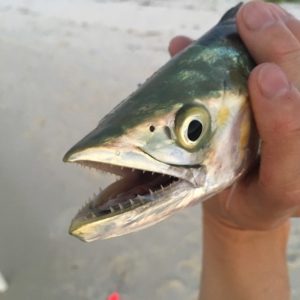
On most days, when there is a chop on the water, 30-40 pound wire might work great. However, if it’s a calm, bright sunny day, wire may be a bad choice, since the fish could see the leader and avoid your bait altogether. In those situations, it might be better to move down to 30 pound mono or fluorocarbon to maximum your bites. But, you can’t get away with that light of a leader if the Spanish are running on the larger size. Larger Spanish can cut through 30 pound mono. So, you may have to step up to 50 to 60 pound instead.
When I use wire for Spanish, I typically go to 29 pound Malin single strand wire (linked below) from Amazon. It’s high quality and it’s pretty cheap.
To attach single strand wire to your hook, use a haywire twist (shown below). There are many good videos online on how to properly tie the haywire twist. It’s really not that hard to do after you practice a few times.

When using a braided mainline, which is more visible, there may be times when you might want to go to a 10 foot flouro leader to get more bites. If that’s the case, attach the leader to your mainline using an “FG” knot. This is an excellent knot for connecting braid to mono, as the knot will easily pass through your rod guides. The FG knot takes a bit of practice to learn to tie properly, and to do so quickly. But, it’s worth the effort, as most knots won’t flow through rod guides as well as the FG knot.
My overall preference is to use a long enough leader (usually 5 foot) that you can cut off and retie several times without having to tie on a new leader. With each fish you catch, the line is going to get more and more frayed. So, you should continually check your line for damage, and cut off and retie at any sign of weakness.
A good leader compromise is 40-50 pound mono, as it’s cheap, fairly invisible under water, and withstands damage to multiple mackerel bites.
One very important aspect of your leader is your swivel selection. DON’T USE A SHINY SWIVEL! If you use a flashy swivel, fish are going to hit your swivel and cut you off. Instead, use a small swivel in a muted color, preferably matte black.
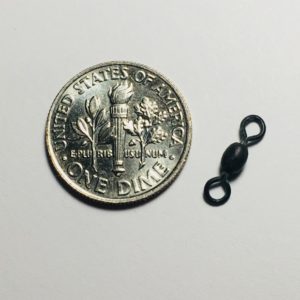
Landing A Spanish Mackerel
Spanish mackerel are an aggressive predator that will hit your offering with significant force. So, typically, they hook themselves without much help from you.
Keep your drag fairly loose, and let them take drag when they are making runs. Don’t reel against the drag, or it will create a lot of twist in your mainline, especially if you are using monofilament or flourocarbon.
Because Spanish mackerel commonly get hooked just inside their mouths, rather than deep in the throat, there is a great risk of the hook pulling free. So, don’t try to horse a Spanish in, rather, you should play them until they are ready to submit.
When unhooking a mackerel of any kind, it’s best to use pliers as you will want to avoid getting cut by their knarley teeth. You also run the risk of getting a hook stuck in your hand when they shake about.
Because of their slender body shape, most Spanish can be controlled by holding them in one hand and de-hooking them with pliers. But, it never hurts to have a Fish Grip (United Plastic 01-3780O Fish Grip) on hand if you are lucky enough to get on some larger fish.
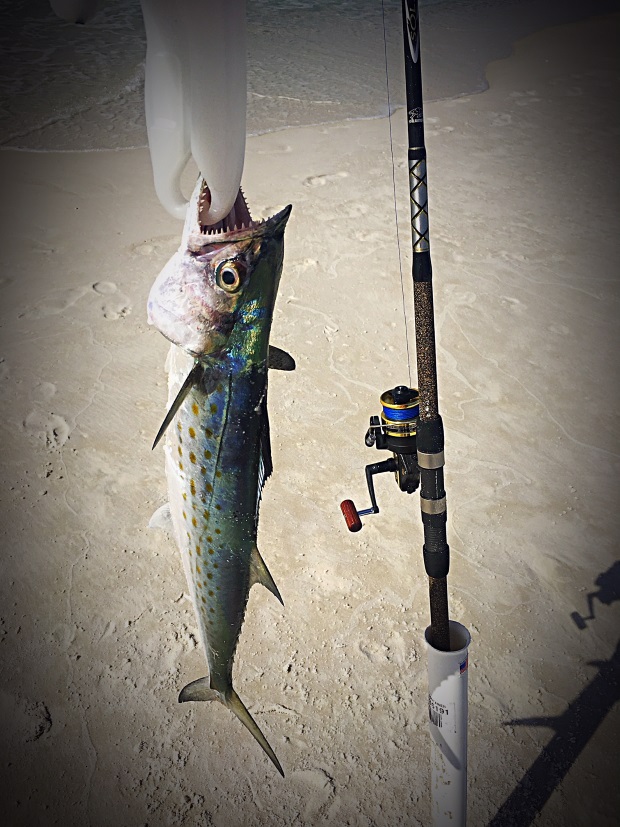
Best Lures For Spanish Mackerel
Since the primary forage of Spanish mackerel is small bait fish such as glass minnows, sardines, menhaden, alewives and anchovies, you will want to stick to fish imitating lures. And typically, smaller profile lures match their forage better and thus outperform larger lures. So, you have lots of options to choose from.
Best Lures For Spanish Mackerel
- Gotcha plugs
- Spoons
- Bubble rigs (a.k.a. straw rigs)
- Diamond jigs
- Banana jigs (Doc's Goofy Jig)
- Pompano jigs
- Bucktail jigs (hair jigs)
- Jerkbaits
- Topwater lures (walk the dog lures)
Because Spanish have such sharp teeth, I like to stick to metals and jigs. I’ve had plenty of success with spoons and gotcha plugs, so I generally stay away from soft plastics and any “fancy” lures. It’s too painful to watch expensive lures get stolen or shredded by a Spanish’s razor sharp teeth. You can add a short trace of light wire above the lure to minimize lure loss, but I typically prefer to stick with heavy mono or flouro to get more bites.
A great cheap option is to use a “straw rig” or “bubble rig”, which is a combination of a treble hook, a short length of drinking straw and a bubble float. More about those below.
When it comes to lure color, silver, gold, white, pink and green are all great options for Spanish.
Using Spoons For Spanish Mackerel
A spoon is a great all-around option for shore-bound fishermen. You can get a spoon that has a fairly small profile, yet still has some weight to it. So, you can match the small bait fish that Spanish prefer, but still have a heavy enough lure that provides great casting distance.
Benefits Of Spoons For Spanish Mackerel
- Wide selection of profile sizes and weights
- Cuts through the wind well
- Extremely durable
- Can be retrieved quickly while maintaining their proper action
- Very flashy (Spanish love shiny)
Besides “matching the hatch” well, spoons are also extremely durable, and hold up well to the daggers inside a Spanish mackerel’s mouth. Spoons are a near perfect choice when targeting Spanish mackerel.
One thing that will steer you away from using spoons is floating grass. If you are fishing an area with a lot of grass, you will want to change out your trebles for a single hook, or move away from a spoon altogether. Depending on the spoon, it might not be a bad idea to also swap out the hooks for something of higher quality. Some spoons don’t have the best hooks, and changing from a treble to a “j” hook is easier on the fishes mouth and easier on your hands in case of an untimely head shake.
Proven Spoons For Spanish Mackerel
- Clarkspoon
- Kastmaster
- Krocodile Spoons
- Johnson Sprite
Lighter spoons, such as Clarkspoons, are primarily used for trolling. However, you can use them from shore “as is”, but you won’t be able to cast very far. This is a hindrance when fishing from a fixed position, however there are several ways that you can effectively fish them and still get good casting distance.
You can use them on a Carolina rig, use them in conjunction with a Clark Caster, or rig them beneath a bubble rig,
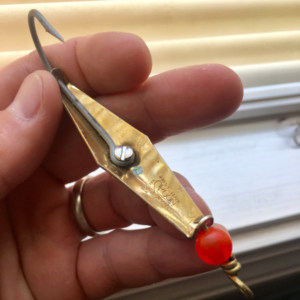
To use them with a bubble rig, you simply substitute the Clarkspoon in place of the treble hook/straw combination that’s normally used under a bubble float.
The same concept applies to a Carolina rig. Just replace whatever bait you normally use on a Carolina rig with a Clarkspoon. But, in this application, you will need to work the rig fast, rather than bumping it slowly along the bottom.
Finally, Clarkspoons can be used in conjunction with something called a Clark Caster. Clark casters contain a weight, a bead and a shiny blade. They attach directly to the spoon with a snap, and provide enough weight to cast a Clarkspoon a long ways. They come in several different weights and run about 4 dollars for a 2-pack.
*When using a spoon, be sure to have a swivel somewhere in your setup. Otherwise, you are going to end up with a twisted main line. A braided main line won’t twist as bad as monofilament or flourocarbon.
Using Gotcha Lures For Spanish Mackerel
Probably the most popular Spanish mackerel lure, for boatless fishermen, is the the Gotcha plug, sold by Sea Striker. There are many configurations and color patterns available today. Chartreuse and white or red and chrome are 2 great choices.

Like casting spoons, Gotcha lures are heavy, yet still small enough to match a small bait fish. The weight and slim profile allows the lure to be cast a very long ways, which is vitally important when trying to reach passing schools.
Because of their small profile and heavy weight, they sink very quickly at the end of a cast. Retrieve them quickly while occasionally, or regularly jerking your rod tip. This causes a deadly darting underwater action that Spanish can’t resist.
Sometimes you will need to allow the lure to drop all the way to the bottom before beginning your retrieve. You never know what depth the fish will be holding, so you may have to probe the entire water column.
Using Bubble Rigs (Straw Rigs) For Spanish Mackerel
Another very common, and effective method for targeting Spanish, particularly from piers and jetties, is the “bubble rig”. This is a very popular rig along the Florida panhandle. You can make your own, or buy pre-made rigs from local tackle shops near the beach. The bubble rigs, also known as straw rigs, could save you a fortune in lures. Not only are they cheap to make, but the straw adds protection to the bottom portion of your leader where it attaches to the hook.
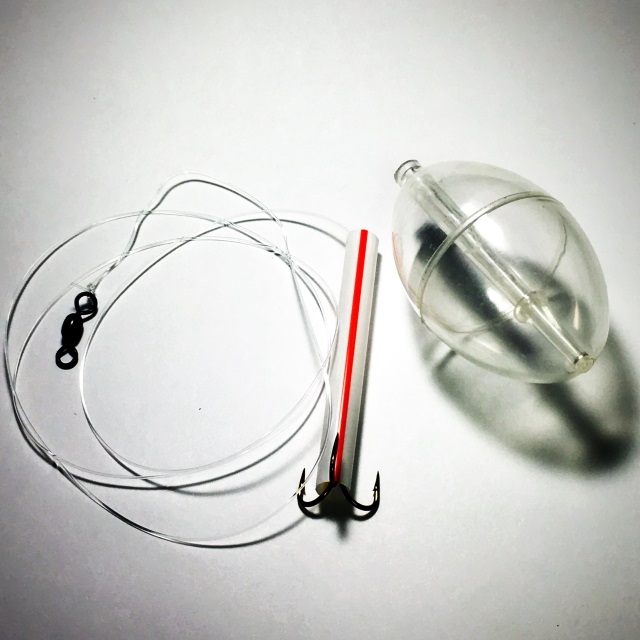
To use a bubble float, pull the plastic center pin out, and hold the float under water to fill it 1/3 to 3/4 full. When working it, cast it out, and fish it fast, popping and dragging it along the surface to create splash and bubbles. This will attract fish, and they will strike the treble/straw combo darting underneath the float.
Below are a couple of examples of what you can buy pre-made, if you don’t want to fool with making your own.
If you are inclined to make your own bubble rigs, gather the following supplies – a medium sized #3 or #4 (preferably gold) treble hook, a bubble float, a 2 or 3 foot section of 30-40 pound monofilament, a small black swivel, and a drinking straw – Mcdonald’s straws are very popular, but white, red and a host of other colors will work as well. Cut the straw into thirds (or 2-3″), tie your hook onto 2 feet of mono, slip the piece of straw onto the line and over the shank of the hook, tie the other end of the mono to your swivel, slide your float onto the mainline followed by a bead, then tie your mainline to your swivel.
As an alternative to the straw, you can also fish a Clarkspoon or Gotcha plug underneath the float. But, part of the beauty of a bubble rig is the minimal expense, and once you start adding expensive lures to it, you defeat that benefit.
Some Final Thoughts About Using Lures For Spanish Mackerel
When using smaller lures, there is a good chance that the fish can get the whole lure inside it’s mouth. That’s when it’s all the more important to have a short length of wire or heavy mono/flouro attached to the lure. Since the fish is potentially going to be chewing on your line as you reel him in you need the extra insurance of a heavier leader.
Regardless of which artificial you choose, the key is to work it fast. Spanish love to pursue fast moving targets. If you aren’t getting bit, you can slow it down, but always start at a high speed.
Using Live Bait For Spanish Mackerel
Since Spanish mackerel spend their lives chasing down schools of small bait fish, the best baits would be just that – a small silvery fish. Scaled sardines, also known as pilchards, whitebait or LY’s, are one great option. But, there are many other little bait fishes that will also work great.
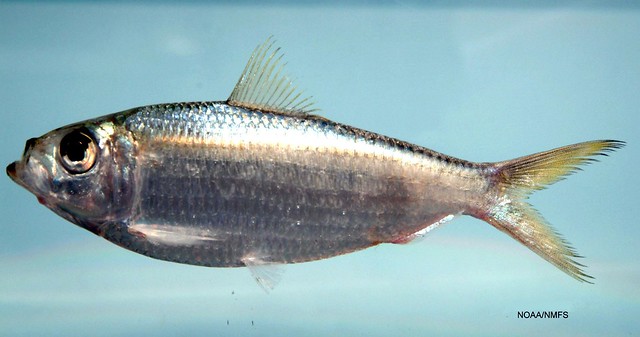
When fishing from a pier or bridge, you can use a sabiki rig to catch whatever small bait fish might be lurking around the pier or bridge pilings. Then, you can cast those small fish back out under a float, or you can free line them. You are looking for baits close to 3″ in size.
Sabiki rigs can be purchased online from Amazon in 10 packs. Here is one example – Sabiki Rig (size 4, 10 Packs) on Amazon. Since sabiki’s are, more or less, a one time use sort of thing, a 10-pack is not a bad deal. However, if you want to purchase just 1 or 2 packs, you are better off picking them up from a tackle shop near the beach, due to price.
When using live bait fish, it’s best to use a loop knot at the end of your leader, so as to allow more action from a struggling bait. Long shank hooks are preferred, so the Spanish won’t bite through your leader during a fight. Long shank hooks actually let you get away with a lighter leader (30 pound), and still avoid a lot of cutoffs. Some people prefer treble hooks instead of long shank hooks. If you use trebles, be sure to use a pretty strong leader, so that the fish won’t bite through.
Spanish can also be caught using live shrimp. It seems the old saying holds up, even for Spanish mackerel – “Everything out there eats a shrimp”.
Live shrimp can be cast out on a bare 3/8 or 1/2 ounce jig head, or suspended under a cork with a treble, or long shank hook. When using a jig head, thread the shrimp onto the jig, tail first, and to where he will be positioned in an upright manner with the hook point coming out his back, not his belly.
Identifying Spanish Mackerel
At this point, you should be in good shape to go out and successfully target Spanish mackerel. However, by doing so, you might also encounter a couple of his closest cousins, the king mackerel and the cero mackerel. It’s important that you can differentiate the 3, because the restrictions will be different.
Juvenile king mackerel look very similar to Spanish mackerel, but kings have a more pronounced dip in their lateral line. Spanish mackerel also have a black spot on their first dorsal fin, which king mackerel don’t have.
When differentiating Spanish from cero mackerel, you can tell the difference by comparing the yellow spots on their sides. Spanish mackerel have very distinguishable yellow dots compared to the mixture of dots and dashes of a cero mackerel.
Viktor Hluben, over at Landshark Outdoors, has the following Youtube video that clearly distinguishes the differences between the three.
What Are The Best Rods, Reels And Line For Spanish Mackerel
If you are going to be casting lures for Spanish, you need a setup that isn’t too heavy, so that you don’t wear down from repeated casting. But, it needs to be long enough that you can cast really far.
I prefer light graphite rods between 8 and 10 feet when fishing from a fixed position. This is the Goldilocks length – long enough to get good distance, but short enough that it isn’t too heavy. A long rod helps you reach passing schools of fish that might normally be out of reach.
Medium action rods with fast tips are good options for targeting Spanish, but you could even go to a light action rod for a more sporting fight. Just make sure your rod is rated to handle the heavy lures and rigs you might want to cast. Ideally, the rod should probably handle up to 2 ounces of lure weight. I have an entire article dedicated to choosing the correct fishing rod here, if you need help with that: Top 9 Criteria to Evaluate When Choosing a Surf Rod
Reels should have fast retrieve ratios, so as to keep up with these speed demons. When it comes to reel sizes, I prefer 2500-5000 sized reels. Basically, you need something that holds about 200 yards of the line of your choice. I usually use my Penn Spinfisher V 4500, which is a little overkill for Spanish, but it’s a versatile reel that I use for a wide variety of fish. I leave it spooled with 20 pound braid and just change the leader, depending on what species I’m after.
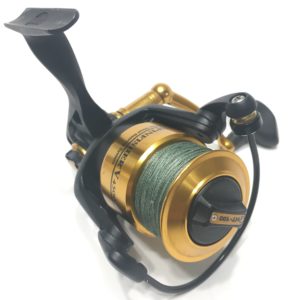
Good main line choices are 12-20 pound monofilament or flourocarbon, or 20 pound braid. Either way you go, you are going to need to tie on a heavier leader as discussed previously.
Are Spanish Mackerel Good To Eat
In short, yes, Spanish mackerel are a great eating fish, WHEN FRESH. However, they don’t freeze particularly well, so it’s best to eat them in the first couple days. Although Spanish don’t really have a large bloodline, it’s also best to cut out any dark meat when you are cleaning a mackerel, as this will ensure best taste. My preferred method of cooking them is to filet them, remove the skin, batter them up, and fry in butter. Many people like to smoke the meat, which is also excellent.
Conclusion
A nice bonus when fishing for Spanish mackerel is that they run in large schools. So, when you find them, you have a great chance at catching way more than one. A big school of Spanish headed your way, busting the surface, with a flock of birds in tow, is an exciting site. Be sure to have a rod rigged up and ready at all times. If you are prepared, you can really load the cooler in a hurry with a pile of tasty filets.
Good luck!
Augustus Clay
If you like this article, check out these other posts about other species you can catch from the surf. How To Catch Pompano From The Surf and How To Catch Whiting.
